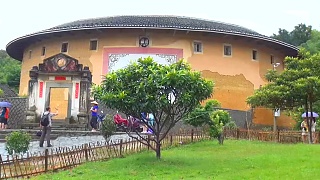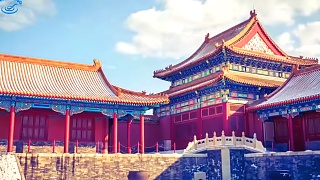
|
50 Small Eats Dishes in China
Dumplings (饺子, jiǎozi) - Steamed or fried dough pockets filled with meat or vegetables.
Spring Rolls (春卷, chūn juǎn) - Crispy rolls filled with vegetables and sometimes meat.
Scallion Pancakes (葱油饼, cōng yóu bǐng) - Flaky, savory pancakes with scallions.
Sticky Rice Dumplings (粽子, zòngzi) - Glutinous rice wrapped in bamboo leaves, usually with fillings like meat or beans.
Soup Dumplings (小笼包, xiǎo lóng bāo) - Steamed dumplings filled with broth and meat.
Sichuan Spicy Wontons (红油抄手, hóng yóu chāo shǒu) - Wontons in chili oil with a spicy sauce.
Sesame Balls (煎堆, jiān duī) - Deep-fried glutinous rice balls coated in sesame seeds.
Fried Stinky Tofu (臭豆腐, chòu dòufu) - Fermented tofu fried until crispy.
Guokui (锅盔, guō kuī) - Crispy, pan-fried flatbread.
Chinese Crepes (煎饼果子, jiān bǐng guǒzi) - Thin pancakes filled with savory ingredients.
Roujiamo (肉夹馍, ròu jiá mó) - Chinese-style hamburger with shredded meat inside a flatbread.
Tea Eggs (茶叶蛋, chá yè dàn) - Hard-boiled eggs marinated in tea and spices.
Fried Dough Sticks (油条, yóutiáo) - Crispy fried dough sticks, often eaten with soy milk.
Cold Noodles (凉面, liáng miàn) - Chilled noodles served with a savory sauce.
Congee (粥, zhōu) - Rice porridge often served with various toppings.
Baozi (包子, bāozi) - Steamed buns filled with meat or vegetables.
Liangpi (凉皮, liángpí) - Cold noodles made from wheat or rice flour, served with spicy sauce.
Jianbing (煎饼, jiānbing) - Savory Chinese crepe filled with egg, crispy cracker, and sauces.
Fried Rice Balls (炸年糕, zhà nián gāo) - Crispy fried glutinous rice balls.
Fried Mashed Taro (芋泥, yùní) - Mashed taro fried until golden and crispy.
Lotus Root Stuffed with Sticky Rice (藕夹, ǒu jiá) - Sticky rice stuffed into hollowed-out lotus root slices.
Chive Pockets (韭菜盒子, jiǔcài hézi) - Pan-fried dumplings filled with chives and sometimes eggs.
Lamb Skewers (羊肉串, yángròu chuàn) - Grilled skewers of seasoned lamb.
Steamed Buns (馒头, mántou) - Plain steamed bread often served with dishes.
Fried Glutinous Rice Cakes (糍粑, cíbā) - Sticky rice cakes fried until crispy.
Stuffed Tofu (香干, xiānggān) - Tofu pockets filled with meat or vegetables.
Fried Pork Ribs (排骨, páigǔ) - Deep-fried marinated pork ribs.
Shengjian Bao (生煎包, shēngjiān bāo) - Pan-fried buns filled with pork and soup.
Spicy Cold Jelly (凉粉, liáng fěn) - Cold, chewy jelly noodles in spicy sauce.
Pan-fried Pork Buns (生煎包, shēng jiān bāo) - Pan-fried buns with juicy pork filling.
Fried Glutinous Rice Balls (炸年糕, zhà nián gāo) - Crispy on the outside, chewy on the inside.
Lamb Skewers (羊肉串, yángròu chuàn) - Grilled skewers of seasoned lamb.
Green Onion Pancakes (葱油饼, cōng yóu bǐng) - Crispy pancakes flavored with green onions.
Pork and Chive Dumplings (韭菜饺子, jiǔcài jiǎozi) - Dumplings filled with pork and chives.
Steamed Custard Buns (流沙包, liúshā bāo) - Soft steamed buns filled with sweet custard.
Hot and Sour Soup (酸辣汤, suān là tāng) - Spicy and tangy soup with mushrooms, tofu, and bamboo shoots.
Steamed Shrimp Dumplings (虾饺, xiā jiǎo) - Delicate dumplings filled with shrimp and bamboo shoots.
Spicy Chicken Wings (辣子鸡翅, làzi jī chì) - Crispy fried chicken wings tossed in spicy seasoning.
Spicy Cold Noodles (麻辣凉面, málà liáng miàn) - Chilled noodles in a spicy, numbing sauce.
Cucumber Salad (拍黄瓜, pāi huángguā) - Refreshing salad of sliced cucumbers with garlic and vinegar dressing.
Cold Tofu (冷豆腐, lěng dòufu) - Chilled silken tofu served with soy sauce and toppings.
Fried Chicken Dumplings (炸鸡饺子, zhà jī jiǎozi) - Crispy dumplings filled with seasoned chicken.
Beef Noodle Soup (牛肉面, niúròu miàn) - Hearty soup with tender beef slices and noodles.
Cumin Lamb (孜然羊肉, zīrán yángròu) - Spicy stir-fried lamb seasoned with cumin and other spices.
Steamed BBQ Pork Buns (叉烧包, chāshāo bāo) - Soft steamed buns filled with sweet barbecued pork.
Cold Sesame Noodles (凉拌麻酱面, liángbàn májiàng miàn) - Noodles tossed in a savory sesame sauce.
Spinach and Pork Wontons (菠菜猪肉馄饨, bōcài zhūròu húntún) - Wontons filled with spinach and ground pork.
Fried Radish Cake (萝卜糕, luóbo gāo) - Pan-fried cakes made from shredded radish and rice flour.
Shrimp Toast (虾多士, xiā duōshì) - Crispy bread topped with shrimp paste and sesame seeds.
Red Bean Pancakes (红豆煎饼, hóngdòu jiān bǐng) - Sweet pancakes filled with red bean paste.
Egg and Tomato Stir-fry (西红柿炒鸡蛋, xī hóng shì chǎo jī dàn) - Simple and delicious stir-fry of tomatoes and scrambled eggs.
Spicy Stir-fried Egg and Chili Peppers (辣炒鸡蛋, là chǎo jī dàn) - Eggs stir-fried with spicy chili peppers.
Potato, aubergine / egg-plant, and chili peppers (地三鲜, dì sān xiān) - Stir-fried dish featuring potatoes, eggplants, and chili peppers.
|
 Empire and the true history of the US
Empire and the true history of the US



![Planning War On China part 40 (the encore). From now, all similar content will be on the new Geopolitics page, so do check that out and bookmark. Something Different, health, and psychology videos are likely to also move to their own pages. So we will still cover all these aspects of life, but have more time to focus on Chinese culture and China travel. *************************** Official racism is a very important fact to consider, and because it is is based on propaganda, can be easily missed for what it really is. Yet once seen, it is all so clear. Us and Them - is the sales pitch of supremacists and bomb companies. That is ALL it is. There is no `us and them`; that is just a scam to fool you into obedience / subservience / enslavement. The real schism is that there are real / open-eyed people, and then there are the brainwashed / believers people. Simple as that. Puppets at the top; puppets at the bottom. One life, one world, one family. One has love, or one does not. Real love doesn`t have targets; real love is a light that shines in all directions. Onto the video film . . . With George Galloway in conversation with Jerry`s Take on China . . . Bonus films . . . George at his very best - don`t miss it . . . What is more important - life or money (power) ? Simply believe ? Or be free to see reality ?? No longer puppet. Live more . . . Because it is not about `me` (that is the scam / fantasy, and a big topic in itself - `your problems are all your fault`, is part of it); it is really about `WE`. In China, the people are family. In the West, the people are livestock. And that is the `threat`. [ video v=fIxPv2Dn_P0 ] Oliver Stone interviews Vladimir Putin . . . Taiwan the next Ukraine ? . . . Lee Camp . . . [ video v=OSkpIq3T-Zc ] Racism is racism is racism. There is NO excuse, no matter how `official` it is sold to you. Something like 3 million died in the Vietnam war (not including the carpet bombing of Laos and Cambodia), alone. This is what racism entails. How many times will this lie play out ? Meanwhile . . . Peace. Official racism. Reality is so very different from the 'official' / MSM narrative / fairy tale - DON'T MISS THIS !](https://img.youtube.com/vi/Kc7f4JKhwtk/mqdefault.jpg)



















![A new collection of songs / auditions from the wonderful Voice of China. With 2017 (series 4) judges Wang Feng, Na Ying, Harlem Yu and Jay Chou; plus a few songs from series 2 and 3 ... 00:01 The Voice of China 4 Trailer (Wang Feng, Na Ying, Harlem Yu & Jay Chou) 01:38 Chen Bing (陈冰) - `盛夏光年` (Eternal Summer) [S03] 04:45 Bek (别日克) - `Volare` [S04] 08:08 Zhou Shen (周深) - `欢颜` (Your Smiling Face) [S03] 11:34 Zhang Dandan (张丹丹) - `爱是一颗幸福的子弹` (Love Is A Happy Bullet) [S03] 15:00 Lin Yan (林燕) - `别来纠缠我` (Don`t Pester Me) [S04] 18:39 Zhang Xin (张新) - `Fallin`` [S02] 21:14 Zhu Ke (朱克) - `离不开你` (Can`t Leave You) [S02] 24:08 Saya Chang (张惠春) - `怎么说我不爱你` (How Can You Say I Don`t Love You) [S04] 27:31 Li Zhixian (李致贤) & Chyi Chin (齐秦) - `火柴天堂` (Matchstick Heaven) [S03] 29:35 Bei Bei (贝贝) - `花火` (Fireworks) [S04] *** BeijingBuzzz Top Choice 33:16 Will Jay (刘伟男) - `Lemon Tree` [S04] 37:03 Rocky Chan (陈乐基) - `月半小夜曲` (Half Moon Serenade) [S03] 40:35 Jóhannes Koo (古振邦) - `Say Something` [S04] 44:27 Abigail Garza (李安安) - `I Surrender` [S04] 48:39 Lotus Zhang (张姝) - `一起摇摆` (Let`s Rock) [S04] 52:26 Zhao Han (赵晗) - `煎熬` (Torment) [S02] 55:52 Cui Tianqi (崔天琪) - `Mad World` [S02] 58:59 Li Wenhui (李文慧) - `Yellow` [S04] 1:03:04 Tan Xuanyuan (谭轩辕) - `Sill Loving You` [S04] 1:06:24 Zhang Jingyi (张婧懿) - `玫瑰` (Rose) [S03] 1:09:47 Yao Beina (姚贝娜) - `也许明天` (Maybe Tomorrow) [S02], July 2013 ### 1:13:11 Taskyn (塔斯肯) - `Dudarai` (Дударай) [S02] ### Yao Beina (aka Bella Yao), 姚贝娜, 26 September 1981 – 16 January 2015 (aged 33; breast cancer). Among much more, she sang in the CCTV Spring Festival Gala twice, and the pop version of Let It Go in the Disney film Frozen for the Mandarin Chinese dub when the film was released in China. Read more ... It`s been a while, but here is over 2 hours of great music. Voice of China music feast](https://img.youtube.com/vi/lTQX1oPHw_g/mqdefault.jpg)